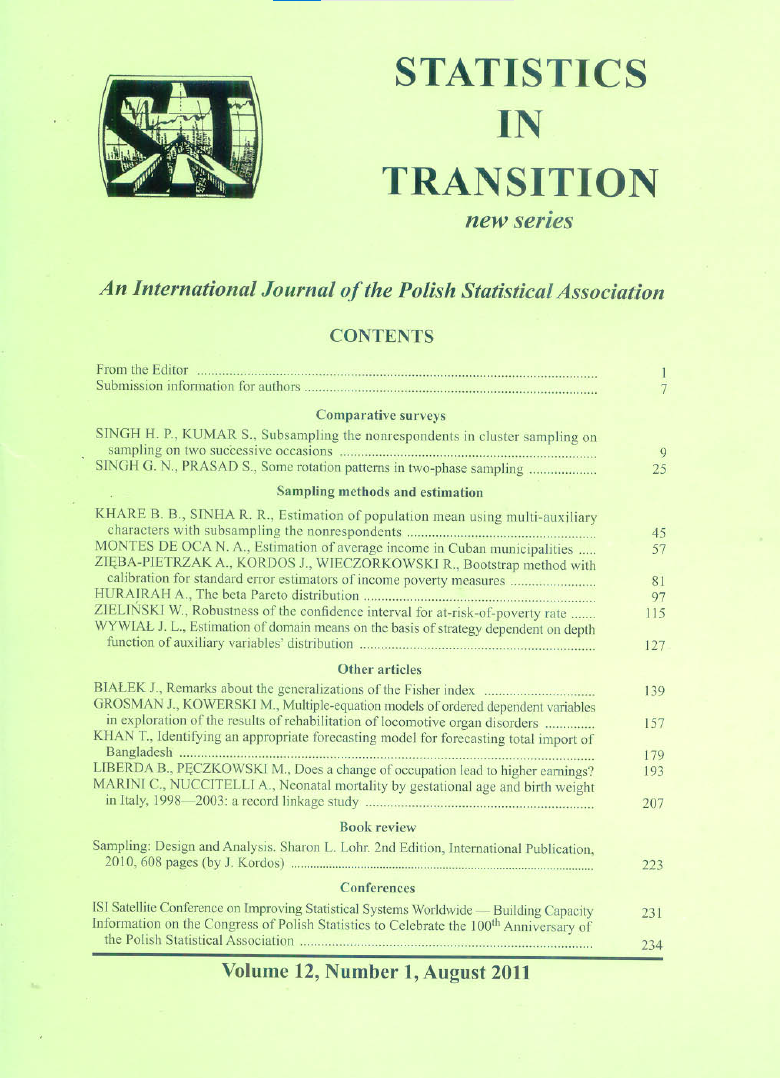ARTICLE
ABSTRACT
Neonatal mortality rates by gestational age and birth weight category are important indicators of maternal and child health and care quality. However, due to recent laws on administrative simplification and privacy, these specific rates have not been calculated in Italy since 1999. The main aim of this work is to assess the possibility of retrieving information on neonatal mortality by the linkage between records related to live births and records related to infant deaths within the first month of life, with reference to 2003 and 2004 birth cohorts. From a strict methodological point of view, some critical aspects of the most used record linkage approach are highlighted: specific problems may arise from the choice of records to be linked if there are consistency constraints between pairs (in this context, one death record can be linked to at most one birth record). In the light of considerations on the quality of the starting data, the retrieval of information on neonatal mortality by gestational age and birth weight is restricted to Northern Italy. Specific neonatal mortality rates are provided with reference to 2003 and discussed with particular emphasis on quality issues in the data collection processes.
KEYWORDS
administrative data, Boolean linear programming, data quality, greedy algorithm
REFERENCES
ARMSTRONG J. B., MAYDA J. E. (1993), Model-based estimation of record linkage error rates, Survey Methodology, 19, 137-147.
ARMSTRONG J., SALEH M. (2000), Weight estimation for large scale record linkage applications, Proceedings of the Survey Research Methods Section, American Statistical Association, 1-10.
BRANUM A. M., SCHOENDORF K. C. (2003), The effect of birth weight discordance on twin neonatal mortality, Obstetrics & Gynecology, 101, 570- 574.
DEMISSIE K., RHOADS G. G., ANANTH C. V., ALEXANDER G. R., KRAMER M. S., KOGAN M. D., JOSEPH K. S. (2001), Trends in preterm birth and neonatal mortality among blacks and whites in the United States from 1989 to 1997, American Journal of Epidemiology, 154, 307-315.
DEMPSTER A. P., LAIRD N. M., RUBIN D. B. (1977), Maximum likelihood from incomplete data via the EM algorithm, Journal of the Royal Statistical Society, B, 39, 1-38.
FELLEGI I. P., SUNTER A. B. (1969), A theory for record linkage, Journal of the American Statistical Association, 64, 1183-1210.
HERZOG T. N., SCHEUREN F. J., WINKLER W. E. (2007), Data quality and record linkage techniques, Springer, New York.
HILL T., PRING-MILL F. (1985), Generalized iterative record linkage system, in: KILSS. B., ALVEY W. (eds.), Record linkage techniques - 1985, Proceedings of the Workshop in Exact Matching Methodologies, Arlington, Virginia, May 9-10, 1985, 327-333.
HORBAR J. D. (1999), The Vermont Oxford network: evidence-based quality improvement for neonatology, Pediatrics, 103, 350-359.
HORBAR J. D., BADGERS G. J., CARPENTER J. H., FANAROFF A. A., KILPATRICK S., LACORTE M., PHIBBS R., SOLL R. F. (2002), Trends in mortality and morbidity for very low birth weight infants 1991-1999, Pediatrics, 110, 143-151.
JARO M. A. (1989), Advances in record-linkage methodology as applied to matching the Census of Tampa, Florida, Journal of the American Statistical Association, 84, 414-420.
MINISTERO DELLA SALUTE (2007), Certificato di assistenza al parto (CeDAP). Analisi dell'evento nascita - Anno 2004, Dipartimento della Qualita, Direzione Generale del Sistema Informativo, Ufficio di Direzione Statistica.
WINKLER W. E. (2000), Using the EM algorithm for weight computation in the Fellegi-Sunter model of record linkage, Statistical Research Report Series RR2000/05, U. S. Bureau of the Census, Washington.
ZEITLIN J., WILDMAN K., BREART G., ALEXANDER S., BARROS H., BLONDEL B., BUITENDIJK S., GISSLER M., MACFARLANE A. (2003), Selecting an indicator set for monitoring and evaluating perinatal health in Europe: criteria, methods and results from the PERISTAT proJect, European Journal of Obstetrics and Gynecology and Reproductive Biology, 111, 5-14.
